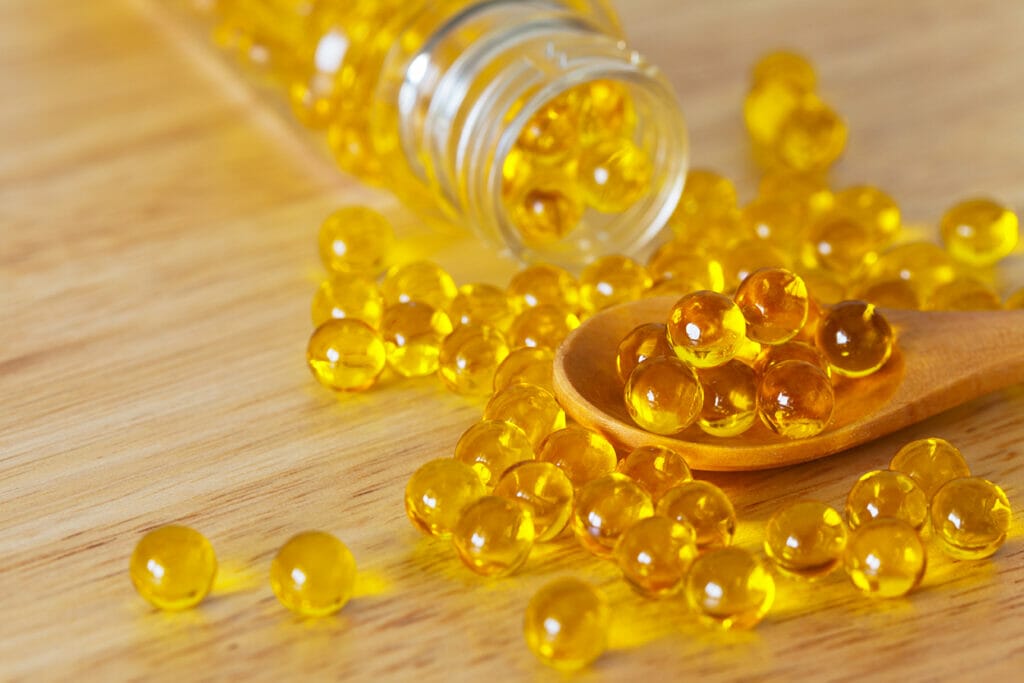Fat-Soluble Vitamins & Probiotics
Continuing with our theme of focusing on specific nutrients we take a brief look at the latest in probiotic research and fat-soluble vitamins (A, D, E, K). It seems that these two long-standing areas of oral intervention in nutritional therapy and related clinical management are experiencing an ongoing and much-welcomed update in terms of application and use.

Fat-Soluble Vitamins
Historically, classical deficiencies of the fat-soluble vitamins (A, D, E, K) were directly correlated with several pathological manifestations such as night blindness (due to Vitamin A deficiency), osteomalacia (due to Vitamin D deficiency), oxidative stress (due to Vitamin E deficiency), and haemorrhage (due to Vitamin K deficiency). However, over the past decade vitamins, A and D, in particular, have been associated with more complex disorders such as cancer and autoimmune diseases as well as having a clear role in immune modulation[9],[10].
We recently witnessed the increased risk for poor outcomes in the population that had metabolic dysfunction and co-infection with SARs Cov 2. Multiple studies have shown that people with metabolic errors, including visceral adiposity, insulin resistance, glucose intolerance, endothelial dysfunction, hypertension, and dyslipidaemia have altered immunocompetence.[11] In part, this is likely to be due to altered utilisation of fat-soluble vitamins, where metabolic change can be combined with genetic sensitivity and result in significant suppression of core fat-soluble vitamin stores.
Fat-soluble vitamins are often less well understood than water-soluble ones, but a recent review (Sept 2022) paper in the journal BMC Nutrition and Metabolism, provides a clear understanding of their importance and risks throughout a lifespan including their role as epigenetic modifiers.
This brings us to Britain’s lifestyle challenge. The country’s unequal healthcare coverage means that by the time people are pleading with Drs from their hospital beds, or struggling to manage their cornucopia of drug prescriptions, it is too late. The UK problem is as much about the absence of prevention as declining access to a cure. Britons and Americans take relatively little exercise, consume a world-beating volume of sugar and fat and feel unalarmed about it as they see so many others doing the same. In effect, behavioural change is very hard to implement when marketing, social interactions and availability of healthy foods are all structured to oppose positive lifestyle changes.[12]
Probiotics – Clostridium Butyricum and Diabetes
Probiotics are steadily evolving their application to specific clinical needs with recognised strains, as opposed to their more familiar nonspecific ecologic application. Research papers continue to show a steady progression of positive use in pre and clinical study outcomes[1].
Determining which probiotic to use and when, for how long, and at what strength remains a challenge. Whilst mouse models help to demonstrate mechanistic pathways, conversion to human health can be problematic, but patterns of application, dosing and timings are becoming better defined. Ultimately as these are not drugs, there will always be variations of action, but as less than 50% of licensed medicines work as intended, they do not have to be right the first time, every time.
In the UK just under 5 million people have diabetes. The cost of diabetes to the NHS is over £1.5m an hour or 10% of the NHS budget for England and Wales. This equates to over £25,000 being spent on diabetes every minute. In the USA over 37million have diabetes, and in both countries, 90% are type two and many are undiagnosed, and even more, are insulin resistant. Metabolic dysfunction is rife. A similar pattern in China where 100m have diabetes and it is estimated that 500m have insulin resistance – (pre-diabetes). In all 3 countries, the costs of treatment are becoming prohibitive, and the related loss of productivity is problematic.
A strategic approach to reversing type 2 diabetes or ideally preventing it is something that requires social engagement, practical tools and clinical and political courage. The cost of current medicines is driving people and ultimately nations into financial difficulty.
For a preventative disease, there is a clear lack of government policy to adopt a lifestyle where risks can be minimised. In addition to lifestyle changes, the role of the GI microbiome has become much clearer. In a paper, out in BMC Microbiology Jan 2022, the role of Clostridium butyricum in the generation of enhanced cardiometabolic health via the production of short-chain fatty acids (SCFAs).[2] SCFAs are proposed to beneficially modulate glucose homeostasis and insulin sensitivity via adipose tissue, skeletal muscle, and liver tissue functions.[3]
In addition, there were indications of increased bile acid production. Bile acids are critical to dietary absorption of lipids and fat-soluble vitamins and also regulate numerous host metabolic pathways. The bile acid receptors, farnesoid X receptor (FXR) and a G-protein-coupled receptor (TGR5), have elicited considerable interest as targets in metabolic diseases.[4],[5],[6]and there is now extensive support for microbiota-dependent modulation of these receptors via modification of bile acids.[7] The authors cautiously suggest that the use of specific bacteria may become a practical addition to lifestyle changes and some medication, to reduce cost and improve outcomes.[8]

Summary
Research around both fat-soluble vitamins and specific probiotic strains is gathering pace and ever-evolving as the volume and interest from the scientific community continue to grow in the interaction between nutrition and health. However individual action can be taken already when it comes to a healthy lifestyle particularly when it comes to choosing what to put into your body.
[1] Bachmann R, Van Hul M, Baldin P, Léonard D, Delzenne NM, Belzer C, Ouwerkerk JP, Repsilber D, Rangel I, Kartheuser A, Brummer RJ, De Vos WM, Cani PD. Akkermansia muciniphila Reduces Peritonitis and Improves Intestinal Tissue Wound Healing after a Colonic Transmural Defect by a MyD88-Dependent Mechanism. Cells. 2022; 11(17):2666
[2] McMurdie, P.J., Stoeva, M.K., Justice, N. et al. Increased circulating butyrate and ursodeoxycholate during probiotic intervention in humans with type 2 diabetes. BMC Microbiol 22, 19 (2022).
[3] Canfora EE, Jocken JW, Blaak EE. Short-chain fatty acids in control of body weight and insulin sensitivity. Nat Rev Endocrinol. 2015 Oct;11(10):577-91. doi: 10.1038/nrendo.2015.128. Epub 2015 Aug 11. PMID: 26260141.
[4] Makishima M, Okamoto AY, Repa JJ, Tu H, Learned RM, Luk A, Hull MV, Lustig KD, Mangelsdorf DJ, Shan B. Identification of a nuclear receptor for bile acids. Science. 1999 May 21;284(5418):1362-5.
[5] Kawamata Y, Fujii R, Hosoya M, Harada M, Yoshida H, Miwa M, Fukusumi S, Habata Y, Itoh T, Shintani Y, Hinuma S, Fujisawa Y, Fujino M. A G protein-coupled receptor responsive to bile acids. J Biol Chem. 2003 Mar 14;278(11):9435-40.
[6] Thomas C, Pellicciari R, Pruzanski M, Auwerx J, Schoonjans K. Targeting bile-acid signalling for metabolic diseases. Nat Rev Drug Discov. 2008 Aug;7(8):678-93.
[7] Wahlström A, Sayin SI, Marschall HU, Bäckhed F. Intestinal Crosstalk between Bile Acids and Microbiota and Its Impact on Host Metabolism. Cell Metab. 2016 Jul 12;24(1):41-50.
[8] Livingston KA, Freeman KJ, Friedman SM, Stout RW, Lianov LS, Drozek D, Shallow J, Shurney D, Patel PM, Campbell TM, Pauly KR, Pollard KJ, Karlsen MC. Lifestyle Medicine and Economics: A Proposal for Research Priorities Informed by a Case Series of Disease Reversal. Int J Environ Res Public Health. 2021 Oct 29;18(21):11364..
[9] Dankers W, Colin EM, van Hamburg JP, Lubberts E. Vitamin D in Autoimmunity: Molecular Mechanisms and Therapeutic Potential. Front Immunol. 2017 Jan 20;7:697.
[10] Charoenngam N, Holick MF. Immunologic Effects of Vitamin D on Human Health and Disease. Nutrients. 2020 Jul 15;12(7):2097.
[11] Honce R, Schultz-Cherry S. Impact of Obesity on Influenza A Virus Pathogenesis, Immune Response, and Evolution. Front Immunol. 2019 May 10;10:1071.
[12] Nauta J, van Nassau F, Bouma AJ, Krops LA, van der Ploeg HP, Verhagen E, van der Woude LHV, van Keeken HG, Buffart LM, Diercks R, de Groot V, de Jong J, Kampshoff C, Stevens M, van den Akker-Scheek I, van der Leeden M, van Mechelen W, Dekker R; PIE=M consortium. Facilitators and barriers for the implementation of exercise are medicine in routine clinical care in Dutch university medical centres: a mixed methodology study on clinicians’ perceptions. BMJ Open. 2022 Mar 15;12(3):e052920.







